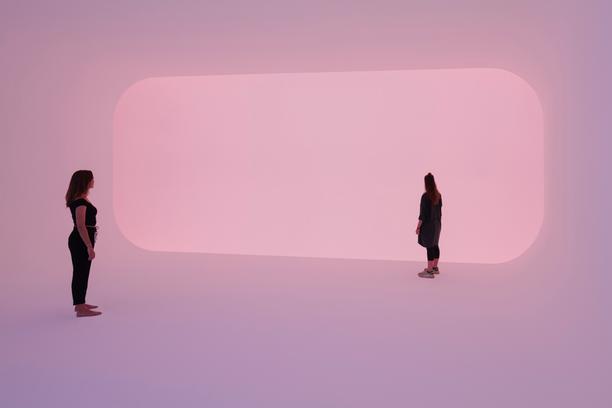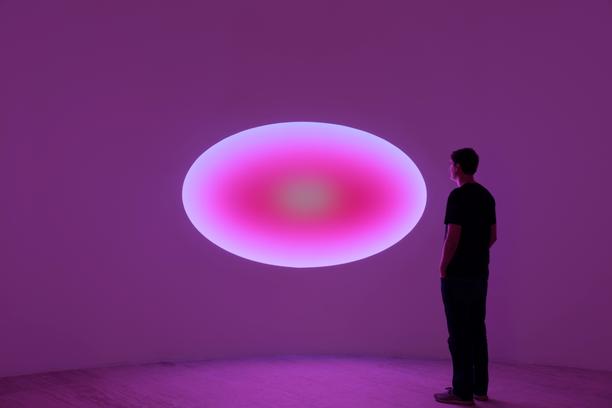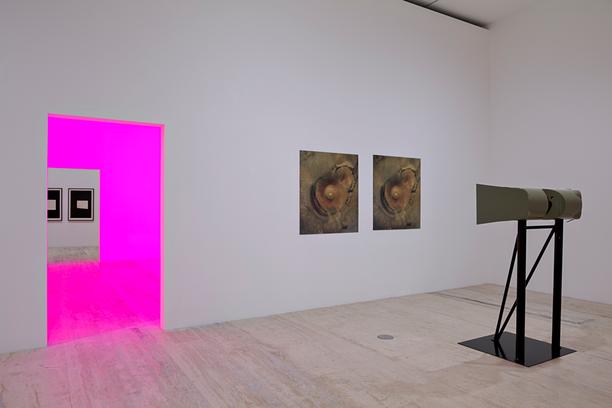
Essay
James Turrell: Passages of Light at the Museo Jumex
by Regina Díaz
Reading time
4 min
Two floors, arrived at only by elevator and in groups of five. Sitting, without shoes, in silence, we wait in the anteroom of an unexpected scene: a blank stage painted with light into which the actors, you and I, hope to enter.
It’s our turn, and we thoroughly follow the instructions of our director: the security guard. A character whose normal role is to go unnoticed, who pretends not to look while looking, who is boxed into corners, and who tends to walk gently by your side while aiming to avoid—unsuccessfully—any influence on your experience. In this piece, the guard fully assumes a presence and unintentionally becomes an orchestra conductor. From the top of the black stairs, above an altar, the guard gives us instructions for entering the painting Amesha Spentas, from the series Ganzfeld.
We climb up, we move forward, and before butting into the wall we stop to look straight at the blank surrounding us. Here we witness the filtration of time; here seeing consists of letting the minutes pass, without hurry. Taking notice of our agency is something so dazed by everyday life that we constantly forget about it, but in this illuminated cube—where the only cue is to observe and wait—we manage to encounter ourselves in the otherness of the light.

We daily regulate our posture: our way of walking, our tone of voice, our words, our registers. We feel and we react; we create guidelines and references from the position of, and in spite of, the other. The painting that you and I previously entered is not free of arrangements; those we saw, while we waited, on the screen—the stage—told us how to breathe, how to guide our eyes and move our bodies.
With light, Turrell alters the structures that surround us: as much the tangible physical ones—architectures built by nature or by us—as the internal and untouchable ones. The blank canvas forces us to forget, to make an effort and give ourselves time. The raw material that Turrell plays with is us and our gaze: he infringes on the way we see in order to cause a visual imbalance. Inside the piece, we question the walls’ depth and imagine possibilities of crossing barriers. I decided to close and open my eyes, teetering back and forth in order to explore the uncertainty of the materiality that surrounded me. The imbalance that I encountered was, thus, clipped—between the contrasts of the lights and the spaces: alone/with others, real/imaginary, dark/light, void/body, visible/invisible, legible/illegible.
And in that I saw all the colors I had already seen in blinks that were not mine.
Our bodies are also contrasts of shapes, sizes, rhythms, capacities, and vulnerabilities. The body—its age, mobility, dimension—is an active part in the construction of our perception. An older woman moves ahead, on her way to the room where one finds Caper, Salmon White (2000), a piece from the series Wedgeworks. I feel her entering the darkness from the uncertainty of her steps. There I realize, next to her, that Turrell probably believes in the existence of a shared gaze. He wagers on the fact that you and I, despite what we are, will see a cube or a sphere; he trusts that we have been educated to understand the same thing, in order perhaps later to challenge it.
The woman asked for help in walking in the dark. It both comforts and frightens me to know that we could have seen so much and that, even so, we have seen the same thing; I embrace the fact that what constitutes our physical capacity to see does not contain our gaze. The passages of light are prostheses in order to see (ourselves): we explore how our material or emotional baggage lets us—or does not let us—see, as well as why we see what we see. At times, we dare to question ourselves in the uncertainty of what surrounds us; thus we challenge those who taught us to see, and we exploit the versatile rebelliousness of the gaze.

What I can see changes all the time,
With every blink, tilt, head up, head down, it is a bumpy dance.
In this city, crammed with structures, we pass through a great deal in order to survive. We suffer from tired eyes; the pictures surrounding us last only seconds, and we see brushstrokes without being able to relish the paint calmly. During my journey home of more than an hour and a half I paid attention to the darkness of the light, and, for seconds, I observed what was not blinded by the light.

The show will remain up until March 29th 2020.
Buy your ticket here.
Published on January 1 2020